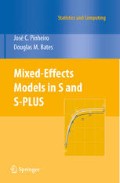Abstract
Many common statistical models can be expressed as linear models that incorporate both fixed effects, which are parameters associated with an entire population or with certain repeatable levels of experimental factors, and random effects, which are associated with individual experimental units drawn at random from a population. A model with both fixed effects and random effects is called a mixed-effects model.
Preview
Unable to display preview. Download preview PDF.
References
Chambers, J. M. and Hastie, T. J. (eds) (1992). Statistical Models in S, Chapman & Hall, New York.
Devore, J. L. (2000). Probability and Statistics for Engineering and the Sciences, 5th ed., Wadsworth, Belmont, CA.
Goldstein, H. (1995). Multilevel Statistical Models, Halstead Press, New York.
Lindley, D. and Smith, A. (1972). Bayes estimates for the linear model, Journal of the Royal Statistical Society, Ser. B 34: 1–41.
Milliken, G. A. and Johnson, D. E. (1992). Analysis of Messy Data. Volume 1: Designed Experiments, Chapman & Hall, London.
Potthoff, R. F. and Roy, S. N. (1964). A generalized multivariate analysis of variance model useful especially for growth curve problems,;; Biometrika 51: 313–326.
Sakamoto, Y., Ishiguro, M. and Kitagawa, G. (1986). Akaike Information Criterion Statistics, Reidel, Dordrecht, Holland.
Schwarz, G. (1978). Estimating the dimension of a model, Annals of Statistics 6: 461–464.
Venables, W. N. and Ripley, B. D. (1999). Modern Applied Statistics with S-PLUS, 3rd ed., Springer-Verlag, New York.
Rights and permissions
Copyright information
© 2000 Springer Verlag New York, LLC
About this chapter
Cite this chapter
(2000). Linear Mixed-Effects Models: Basic Concepts and Examples. In: Mixed-Effects Models in Sand S-PLUS. Statistics and Computing. Springer, New York, NY. https://doi.org/10.1007/978-1-4419-0318-1_1
Download citation
DOI: https://doi.org/10.1007/978-1-4419-0318-1_1
Publisher Name: Springer, New York, NY
Print ISBN: 978-1-4419-0317-4
Online ISBN: 978-1-4419-0318-1
eBook Packages: Springer Book Archive

